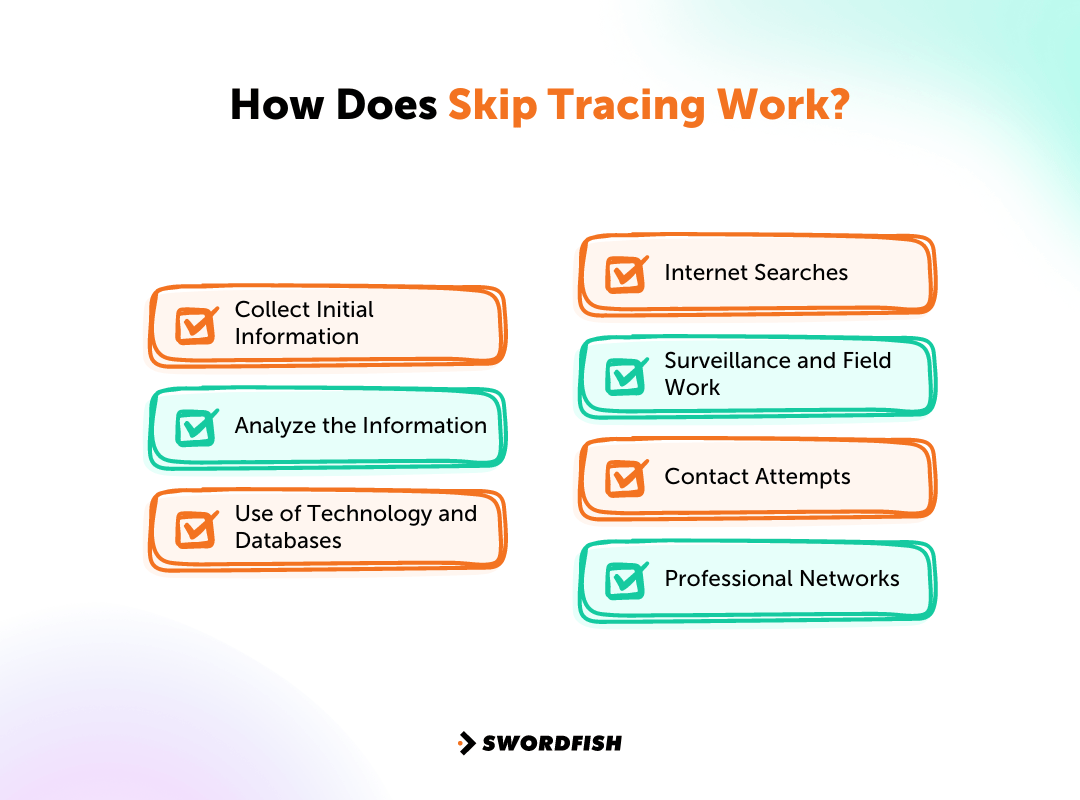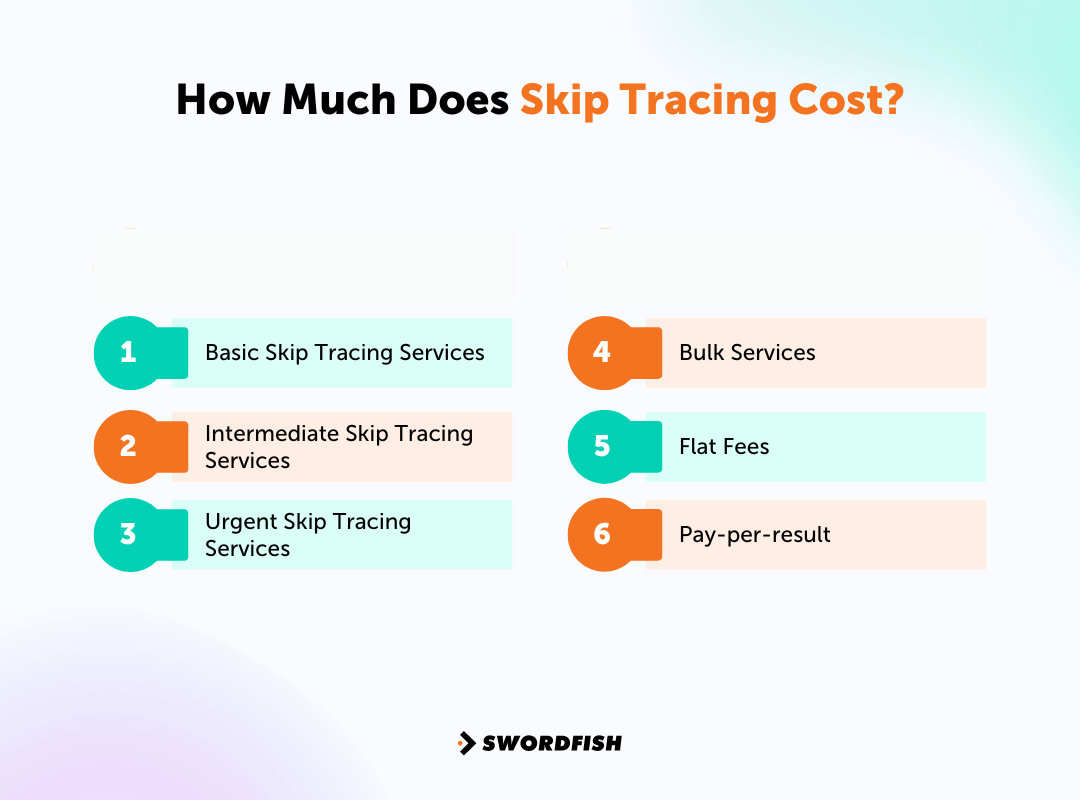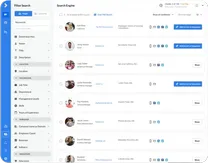
Have you ever needed to find someone who seems to have disappeared into thin air? Whether it’s a non-paying client or a missing family member, skip tracing helps tackle the frustration of outdated records, dead-end leads, and deliberate evasions. Skip tracing offers a solution to locate those who are hard to find.
So, what is skip tracing? Skip tracing is the process of finding someone’s location using data analysis and research. It involves gathering personal information from various sources to trace the person’s recent activities and current location.
In the next sections, you’ll learn the exact definition of skip tracing, who needs it, and why it is important. You’ll also discover detailed methods for skip tracing someone.
So, make sure to read till the end for comprehensive insights of skip tracing.
What is Skip Tracing?
Skip tracing is a process used to find someone who is hard to locate, often for legal or financial reasons. Investigators collect data from various sources, such as public records, credit reports, and social media, to determine the person’s current whereabouts.
If you need to find someone who isn’t easy to track, skip tracing can help. This technique uses a variety of information sources, allowing you to piece together their location.
You might access databases that compile phone numbers, addresses, and even job details. It’s useful for legal, financial, or personal situations where connecting with a missing person is important.
Why is Skip Tracing Important?
Skip tracing is a valuable tool that can make a big difference in many situations. Here’s why it should matter to you:
Locating Individuals
If you need to find someone who has moved without leaving a forwarding address, like a debtor or a long-lost family member, skip tracing is the tool you need. It uses public records, databases, and sometimes more intensive search techniques to discover someone’s current location.
Debt Collection
When trying to collect unpaid debts, skip tracing can help you locate hard-to-find debtors. This is crucial for recovering financial losses and maintaining your business’s financial health.
Legal Processes
In legal matters, serving documents to the correct person is essential. Skip tracing ensures that legal notices are delivered accurately, allowing legal processes to proceed fairly and efficiently.
Ensuring Safety and Compliance
In cases involving criminal activities or court orders, quickly finding individuals is critical for safety and legal compliance. Skip tracing tools help law enforcement and legal entities locate people needed for legal reasons or to prevent potential harm.
Asset Recovery
Skip tracing can also help locate hidden or transferred assets. Whether for repossessing property or finding assets for estate settlements, skip tracing provides essential information for various asset recovery operations.
Who Needs Skip Tracing?
Skip tracing is utilized by various professionals to locate individuals for financial, legal, or investigative reasons. Here are some examples:

Debt Collectors and Creditors
If you’re trying to recover debts, skip tracing can help you find people who owe money and have become hard to reach. It helps you locate their contact information or current addresses, boosting your chances of recovering debts.
Private Investigators
As a private investigator, you might use skip tracing to find missing persons or individuals involved in legal issues. Whether it’s for personal, legal, or financial reasons, this tool enables you to track down people whose locations are unknown.
Law Enforcement Agencies
If you work in law enforcement, skip tracing is important when locating suspects, witnesses, or anyone else involved in a criminal case. This technique ensures that all relevant individuals are reachable for questioning or trials, helping you enforce the law effectively.
Real Estate Investors
If you’re a real estate investor, skip tracing can help you identify owners of abandoned or neglected properties who might be interested in selling. This can open up new investment opportunities for you that aren’t listed on the usual markets.
Banks and Financial Institutions
For those working in financial institutions, skip tracing is important to find people who have defaulted on loans or other financial obligations. This process is key to effective asset recovery and minimizing financial losses.
Journalists and Researchers
As a journalist or researcher, you might use skip tracing to locate sources or individuals who can provide much information for your stories or studies. This method can help you find elusive sources, making your work more thorough and accurate.
How Does Skip Tracing Work?
Skip tracing is a method used to find someone who can’t be easily located through usual methods. But it’s not rocket science. Here’s a straightforward explanation of how it works:

Verify Information
First, you verify the debtor’s contact information. This involves checking addresses, phone numbers, and email addresses. Accurate information helps you start the process on the right foot.
Search Public Records
You then collect publicly available information. This includes looking at address history, court records, and social media profiles. This data helps you build a clearer picture of the debtor’s whereabouts.
Contact Known Associates
Next, you reach out to the debtor’s friends and family. These contacts might provide insights into the debtor’s location. If necessary, you can also contact previous landlords or employers.
Utilize Specialized Tools
Professional skip tracers use advanced software. These tools can cross-reference vast amounts of data quickly. They are often too expensive for individual use but are highly effective.
How to Skip Trace Someone
Skip tracing someone involves using various methods to locate an individual when they can’t be reached through normal communication channels. Here’s a straightforward, step-by-step guide on how to skip trace someone:

Gather Initial Information
Start by collecting all known information about the person. This includes their full name, previous addresses, phone numbers, date of birth, and other relevant details like email addresses or known associates. This data lays the groundwork for your search.
Search Public Records
Look into public records such as court files, marriage and divorce records, voter registrations, and property ownership documents. Many of these records are accessible online and can provide insights like new addresses or associated names.
Use Online Search Engines
Search online using major search engines. Personal data from social media, blogs, or websites can help locate someone through information they’ve shared online. This might include their current contact information or hints about their location or activities.
Check Social Media
Explore their social media profiles on platforms like Facebook, Twitter, Instagram, and LinkedIn. People often post about their lives, including locations and recent life changes, which can be clues to where they are now.
Utilize Specialized Databases
Access databases specifically designed for skip tracing, which compile data from various sources to provide current addresses, phone numbers, and employment details. These databases usually require a subscription and are commonly used by professionals like private investigators.
Contact Known Associates
Reach out to the person’s friends, family, and former employers. They may not give you a direct address but could provide useful leads to continue your search.
Employ Reverse Phone Lookups
If you have an old phone number, use reverse phone lookup services to get the latest address or name linked to that number. This can be a direct route to find someone if their phone number hasn’t changed.
Hire a Professional
If your efforts don’t pan out, or if you need a more discreet approach, consider hiring a professional like a private investigator. They have access to advanced tools and resources that aren’t available to the public and can conduct a more comprehensive search.
Should You Hire a Skip Tracer for Debt Collection?
Yes, you should consider hiring a skip tracer for debt collection. Skip tracers have specialized skills and tools to locate individuals who are difficult to find. They save you time and increase the chances of recovering the money owed to you.
Hiring a skip tracer can save you significant time and effort. Skip tracers have access to specialized tools and databases that you might not. They can quickly gather and analyze information to locate hard-to-find debtors. This is especially useful if you have other business priorities.
However, be aware that hiring a skip tracer can be costly, with fees often ranging from 25% to 50% of the collected debt. If the potential recovery amount justifies the cost, hiring a professional is wise.
How Much Does Skip Tracing Cost?
The cost of skip tracing varies widely depending on the search’s complexity and the resources needed. Let’s take a look at the breakdown of typical fees:

Basic Skip Tracing Services
Prices for basic services generally start at $20 and can go up to $350. This level typically covers simple searches using publicly accessible information or basic database checks.
Intermediate Skip Tracing Services
For more detailed searches that need extra resources or time, costs range from $450 to $800. This level is often required when the person has left minimal traces or when thorough database checks are needed.
Urgent Skip Tracing Services
When results are needed quickly, typically within a week, the cost can rise to between $500 and $1,000. This higher price reflects the urgent nature of the service and the intensive effort needed to collect information rapidly.
Bulk Services
Bulk skip tracing services, designed for clients needing to locate multiple individuals simultaneously, usually cost about $0.10 per record. This model can significantly reduce costs when managing large volumes, though the data’s quality and accuracy may vary.
Flat Fees
Many skip tracing providers charge a flat fee, typically around $100 per trace. This fee covers essential information such as addresses, employment details, and some criminal history. The flat fee model is beneficial because it offers transparent pricing upfront, helping you budget effectively without unexpected charges.
Pay-per-result
In the pay-per-result model, you are only charged for successfully retrieved information, usually costing between $0.15 and $0.25 per result. This cost-effective method lets you pay only for the specific information you need, making it ideal if you don’t require a comprehensive background report.
Swordfish AI: Best Tools for Skip Tracing

If you’re looking for top-tier tools to do skip tracing, Swordfish AI could be your best bet. This platform offers many powerful features to enhance skip tracing efficiency.
Swordfish AI provides a Chrome extension that allows you to collect contact information from websites like LinkedIn and Facebook seamlessly. Thus making it easier to collect data while browsing online.
Additionally, its extensive database provides over 3.5 billion profiles, offering a vast pool of data for more accurate skip tracing.
What makes Swordfish AI stand out is its advanced search capabilities that go beyond basic filters. You can customize your search based on property type, potential equity, and historical property data. This ensures that you find exactly what you need with precision.
Overall, Swordfish AI equips you with the necessary tools to connect with high-quality leads efficiently, improving your success in real estate investments.
Features of Swordfish AI
Here are the notable features of Swordfish as the best skip tracing tool:
Prospect Search

With Swordfish AI’s Prospect Search, you can quickly find detailed contact information for individuals. This is important in skip tracing as it helps you locate people faster by accessing their phone numbers, email addresses, and social profiles.
Chrome Extension

The Chrome Extension makes your skip tracing seamless. While browsing online, you can instantly gather contact details directly from websites and social media platforms like Facebook and LinkedIn.
Enrich Files

The Enrich Files feature allows you to upload multiple contacts at once. You can process large lists of individuals to find updated contact information, which is especially useful when you’re dealing with numerous leads in skip tracing.
Reverse Lookup

Reverse Lookup helps you work backwards from limited information. You can get full contact details if you only have a phone number or an email. This is invaluable for effectively tracing difficult-to-find individuals.
API Integration

Integrate Swordfish AI with your existing tools and databases for a simplified workflow. This API Integration ensures you can automate data retrieval and management, making the skip tracing process more efficient.
Bombora Intent Data

The Bombora Intent Data feature provides insights into an individual’s recent activities and interests based on their digital footprint. Understanding a subject’s recent interests can help you predict their whereabouts or future actions, enhancing your skip tracing strategies.
Conclusion
In this guide, we’ve covered what skip tracing is and how it works, pointing out the challenges and effective strategies you might encounter.
Knowing the right methods of skip tracing is key because it boosts your ability to find people quickly and accurately.
Among the tools you can use, Swordfish AI stands out. It offers accurate, real-time validated contact data, making your skip tracing tasks much easier. With Swordfish AI, you can reach the right people with minimal effort.
Frequently Asked Question
Is skip tracing legal?
Yes, skip tracing is legal as long as it complies with laws like the Fair Credit Reporting Act (FCRA) in the United States and avoids illegal actions such as trespassing or unlawfully obtaining private information. It’s important to follow legal standards and respect privacy.
Can skip tracing fail?
Yes, skip tracing can fail if the information available is outdated or insufficient or if the person being traced has effectively hidden their whereabouts. Failures usually occur when tracking individuals who prefer not to be found, presenting complex challenges.
Can skip tracing be done internationally?
Yes, skip tracing can be conducted internationally, but it comes with additional challenges and higher costs. Differences in legal systems and the varying availability of data across countries can make it harder to locate individuals across borders.


 View Products
View Products
















